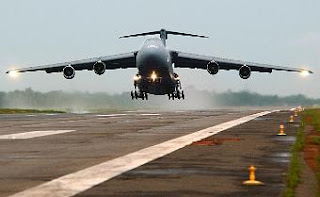The C-5 Galaxy (USAF Photo)
In yesterday’s Washington Times, Delaware Senator Tom Carper responded to a recent op-ed by New Jersey Congressman Jim Saxton, who has called for cancellation of the troubled C-5 modernization program, so that the Air Force can buy more C-17s. With refurbishment costs now approaching $100 million per aircraft, Mr. Saxton argues that it makes little sense to modernize the C-5, which has a 25% lower mission capability rate than the newer C-17.
Not surprisingly, Senator Carper disagrees. As we’ve noted in the past, Mr. Carper and other members of the Senate have a vested interest in keeping the C-5 in service, and he remains a strong backer of the refurbishment effort. However, his arguments sound slightly less-than-convincing:
It is true that in the past, the C-5 has experienced a lower reliability rate than the much newer C-17. The mission capable rates for the C-5A have frequently fallen below 50 percent, and the rate for the C-5Bs hovers somewhere around 65 percent.
But Congress and the Bush administration realized the need to correct this reliability issue several years ago and directed the Air Force to begin the process of modernizing its C-5s, given the likelihood that the large cargo aircraft have another 25 years or more of useful life on their wings and fuselages. To date, the Air Force has worked with a contractor to modernize three C-5Ms, and it is flight testing and evaluating the aircraft to determine if it will meet the contractor-guaranteed mission capable rate of 75 percent.
While we won’t know with absolute certainty until June 2010 whether the C-5 modernization process will increase the reliability to the specified rate, flight-test results over the past year suggest that it will likely be met, and possibly exceeded.
In other words, Mr. Carper believes we should continue with the modernization program, in hopes that it can meet specified bench marks–in three years. Meanwhile, the cost of converting C-5As and C-5Bs to the new “M” standard has skyrocketed. Recent Air Force estimates put the cost per aircraft at $120 million per aircraft, while Lockheed maintains it can do the job for $83 million each. By comparison, a new C-17 costs about $200 million.
It is true that the a single C-5 can fly missions that would require the services of two C-17s–plus tanker support. And, in a perfect world, the Air Force would benfit from a mix of C-5s and C-17s. But, in the current budget environment, it seems increasingly likely that the service can’t afford both programs. Facing that reality, the Pentagon (and the nation) may be better off by retiring the C-5 and concentrating on a newer airlifter, one that offers superior reliability, lower maintenance costs and a much longer service life.
We’ll give Mr. Carper credit for trying to protect a program that’s important to his state’s largest military installation, Dover AFB. But, in our view, it’s becoming difficult to support a modernization program that has grown increasingly expensive, and has only an outside chance of meeting required performance standards.


